RESEARCH
Huge poorrich inequalities in maternity care: an international comparative study of maternity and child care in developing countries
Giantes inégalités entre riches et pauvres dans le domaine des soins maternels : étude comparative internationale des soins délivrés à la mère et au nouveau-né dans les pays en développement
Grandes desigualdades entre pobres y ricos en atención de maternidad: estudio comparativo internacional de la atención de maternidad y la atención infantil en los países en desarrollo
Tanja AJ HouwelingI,1; Carine RonsmansII; Oona MR CampbellII; Anton E KunstI
IDepartment of Public Health, Erasmus MC University Medical Center, Rotterdam, The Netherlands
IIDepartment of Infectious and Tropical Diseases, London School of Hygiene and Tropical Medicine, London, England
ABSTRACT
OBJECTIVE: Progress towards the Millennium Development Goals for maternal health has been slow, and accelerated progress in scaling up professional delivery care is needed. This paper describes poorrich inequalities in the use of maternity care and seeks to understand these inequalities through comparisons with other types of health care.
METHODS: Demographic and Health Survey (DHS) data from 45 developing countries were used to describe poorrich inequalities by wealth quintiles in maternity care (professional delivery care and antenatal care), full childhood immunization coverage and medical treatment for diarrhoea and acute respiratory infections (ARI).
FINDINGS: Poorrich inequalities in maternity care in general, and professional delivery care in particular, are much greater than those in immunization coverage or treatment for childhood illnesses. Public-sector inequalities make up a major part of the poorrich inequalities in professional delivery attendance. Even delivery care provided by nurses and midwives favours the rich in most countries. Although poorrich inequalities within both rural and urban areas are large, most births without professional delivery care occur among the rural poor.
CONCLUSION: Poorrich inequalities in professional delivery care are much larger than those in the other forms of care. Reducing poorrich inequalities in professional delivery care is essential to achieving the MDGs for maternal health. The greatest improvements in professional delivery care can be made by increasing coverage among the rural poor. Problems with availability, accessibility and affordability, as well as the nature of the services and demand factors, appear to contribute to the larger poorrich inequalities in delivery care. A concerted effort of equity-oriented policy and research is needed to address the huge poorrich inequalities in maternity care.
RÉSUMÉ
OBJECTIF: Les progrès en direction de lobjectif du Millénaire pour le développement relatif à la santé maternelle sont lents et il faut accélérer le processus délargissement de laccès à des soins par un professionnel de la santé pendant laccouchement. Le présent article décrit les inégalités entre riches et pauvres dans le recours aux soins de santé maternels et sefforce dexpliquer ces inégalités à travers des comparaisons avec dautres types de soins de santé.
MÉTHODES: Les données denquêtes démographiques et sanitaires (DHS) menées dans 45 pays en développement ont été utilisées pour décrire, par quintiles de richesse, les inégalités riches/pauvres en matière de soins maternels (soins avant et pendant laccouchement délivrés par des professionnels de la santé), de complétude de la couverture vaccinale infantile et de traitement médical des diarrhées et des infections aigües des voies respiratoires (IRA).
RÉSULTATS: Les inégalités entre riches et pauvres en matière de soins maternels en général et de soins délivrés pendant laccouchement par des professionnels de la santé en particulier sont beaucoup plus importantes que celles relatives à la couverture vaccinale ou au traitement des maladies de lenfance. Les inégalités entre secteur public et secteur privé contribuent pour une large part aux inégalités riches/pauvres concernant la présence lors de laccouchement dun professionnel de santé. Dans la plupart des pays, même les soins délivrés lors de lacouchement par des infirmières ou des sages femmes bénéficient davantage aux riches. Si de fortes inégalités riches/pauvres touchent aussi bien les zones urbaines que rurales, la plupart des naissances intervenues sans lassistance dun professionnel de la santé concernent des ruraux pauvres.
CONCLUSION: Les inégalités riches/pauvres en matière de soins à laccouchement délivrés par un professionnel de la santé sont beaucoup plus importantes que celles observées pour dautres formes de soins de santé. Réduire les inégalités riches/pauvres dans laccès à ces soins est essentiel pour atteindre lOMD relatif à la santé maternelle. Les plus fortes améliorations de cet accès sobtiendront en élargissant la couverture des populations rurales pauvres. Des problèmes de disponibilité et daccessibilité physique ou économique, ainsi que le type de service et des facteurs liés à la demande, semblent les principaux responsables des inégalités riches/pauvres dans les soins reçus lors de laccouchement. Un effort concerté simpose pour élaborer des politiques et mener des recherches orientées vers léquité en vue de faire face aux inégalités considérables entre riches et pauvres en matière de soins maternels.
RESUMEN
OBJETIVO: Los progresos hacia los Objetivos de Desarrollo del Milenio relacionados con la salud materna han sido lentos, lo que obliga a acelerar la expansión de la atención profesional durante el parto. En este artículo se describen las desigualdades entre pobres y ricos en cuanto al uso de los servicios de maternidad y se intenta comprender dichas desigualdades realizando comparaciones con otros tipos de atención de salud.
MÉTODOS: Se utilizaron datos de las Encuestas de Demografía y Salud de 45 países en desarrollo para describir las desigualdades entre pobres y ricos por quintiles de riqueza en materia de atención de maternidad (atención prenatal y obstétrica por profesionales), completud de la cobertura de inmunización infantil y tratamiento médico de la diarrea y las infecciones respiratorias agudas.
RESULTADOS: Las desigualdades entre pobres y ricos en lo relativo a la atención de maternidad en general y la atención obstétrica profesional en particular son mucho mayores que las que afectan a la cobertura inmunitaria o el tratamiento de las enfermedades de la infancia. Las desigualdades en el sector público constituyen una parte importante de las desigualdades entre ricos y pobres en materia de atención obstétrica profesional. Incluso la atención al parto proporcionada por enfermeras y parteras favorece a los ricos en la mayoría de los países. Aunque las desigualdades de ese tipo son considerables tanto en las zonas rurales como en las urbanas, la mayoría de los nacimientos sin atención obstétrica profesional se dan en la población rural.
CONCLUSIÓN: Las desigualdades entre pobres y ricos en atención obstétrica profesional son mucho mayores que las observadas en las otras formas de atención. La reducción de esas disparidades es fundamental para alcanzar los ODM relacionados con la salud materna. Aumentar la cobertura de la población rural pobre es la medida más idónea para mejorar la atención obstétrica profesional. Los problemas de disponibilidad, accesibilidad y asequibilidad, así como la naturaleza de los servicios y los determinantes de la demanda, parecen ser los factores que más contribuyen a las amplias desigualdades entre ricos y pobres en atención obstétrica. Se requiere un esfuerzo concertado para imprimir mayor equidad a las políticas y las investigaciones si se desea corregir las grandes desigualdades entre ricos y pobres en atención de maternidad.
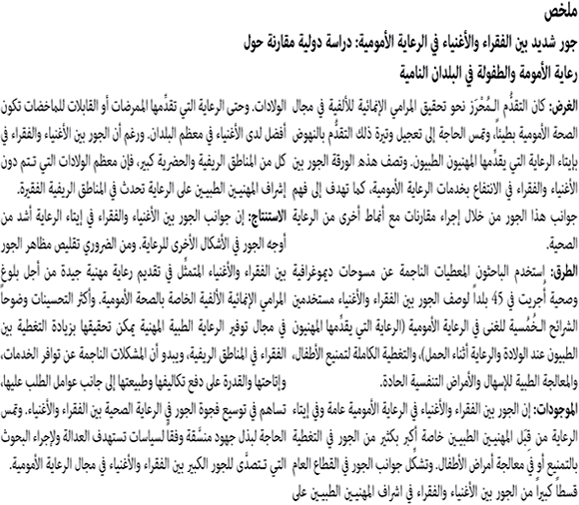
Introduction
Over half a million women die each year during pregnancy, delivery or shortly thereafter;1 the Millennium Development Goals (MDGs) call for reducing maternal mortality by 75% by 2015.2 Since maternal mortality is costly to measure3 and professional attendance at delivery is assumed to reduce maternal mortality,4 the proportion of deliveries with a professional or skilled attendant is used as a progress indicator.5 Slow progress towards the MDG for maternal health6 has led to calls for accelerated progress in scaling up professional delivery care.7
Poorer groups within developing countries use less health care8 and poorrich inequalities in maternity care and maternal mortality have been described.911 Within-country inequalities in maternity care have, however, not been described in detail for a broad range of dimensions using an international comparative perspective. Nor have they been systematically compared with inequalities in other forms of care. A better understanding of the magnitude and determinants of inequalities in maternity care may help contribute to tackling these disparities and to reaching the MDGs for maternal health. They may also contribute to the MDGs for child health, as skilled attendance at delivery is an important contributor to neonatal survival.1
This paper describes poorrich inequalities in use of professional delivery and antenatal care for 45 developing countries and compares these to inequalities in use of child health services. By presenting various aspects of inequalities in the use of maternity care, and by contrasting these to inequalities in the use of child health care, this paper seeks possible explanations for the inequalities observed in maternity care.
Data and methods
Data on health care use, stratified for five wealth groups, were obtained for 45 developing countries from World Bank Country Reports.12 All countries for which these reports were available at the time of analysis were included in our study (Table 1).
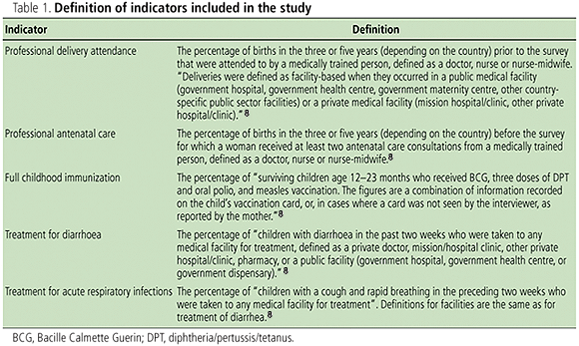
Data for these reports were derived from Demographic and Health Surveys (DHS) conducted between 1990 and 1998.13 These are nationally representative household surveys that usually cover between 5 00010 000 women aged 1549 years. They include information on health care use and household ownership of assets. All the types of health care use available in these reports were included in this paper. Table 1 defines the health care use indicators included in this study.
Household ownership of durable consumer goods, housing quality, and water and sanitation facilities were combined into a wealth index using principal components-derived weights.8,14 Wealth groups were constructed such that each consisted of 20% of the survey population unless otherwise indicated. Despite limitations,15 this index has been used fairly widely as a measure of economic status in developing countries.14,16
The main inequality measures we used are the rate ratio (RR) and the rate difference (RD). The RR gives the ratio of health care use among the richest to the poorest group within a country, whereas the RD gives the absolute difference in health care use between these groups.
We estimated the distribution of the total number of births without a professional delivery attendant across the rural poor, rural rich, urban poor and urban rich. This was done by calculating the total number of deliveries without a professional delivery attendant in each of the groups as a proportion of the total number of deliveries without such an attendant in the total survey population. For this analysis, the poor were defined as the bottom 50% of the total survey population.
To assess the relationship between the magnitude of poorrich inequalities in health care use and the overall level of such use, we plotted, for each of the five types of health care, the RR in health care use against the overall level of health care use for the 45 countries. We fitted exponential curves through each of the scatter plots. For reasons of readability, Fig. 8 only shows the exponential curves, and not the scatter plots themselves.
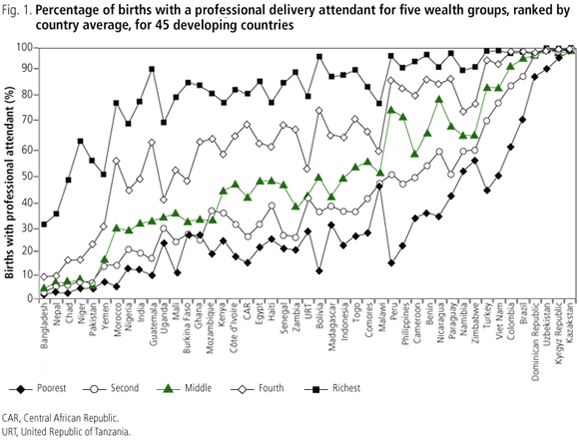
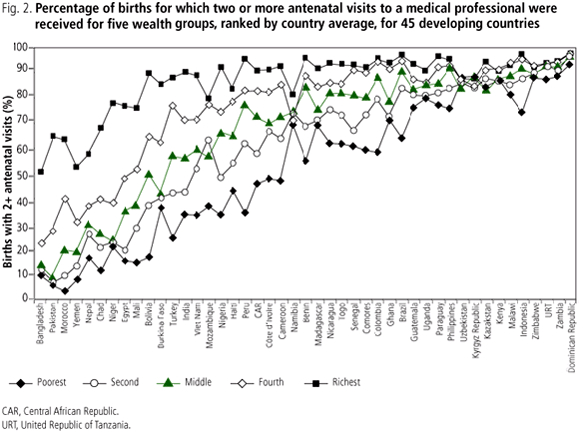
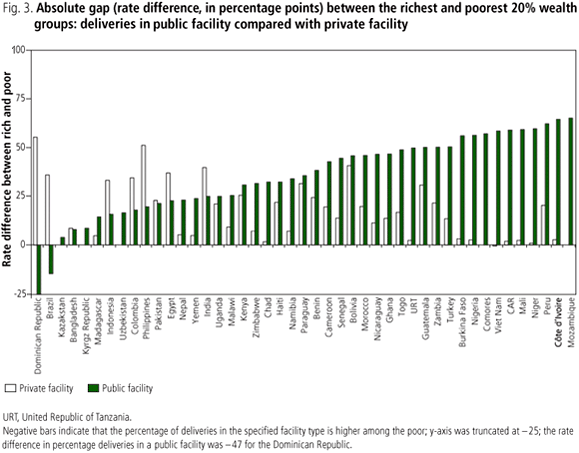
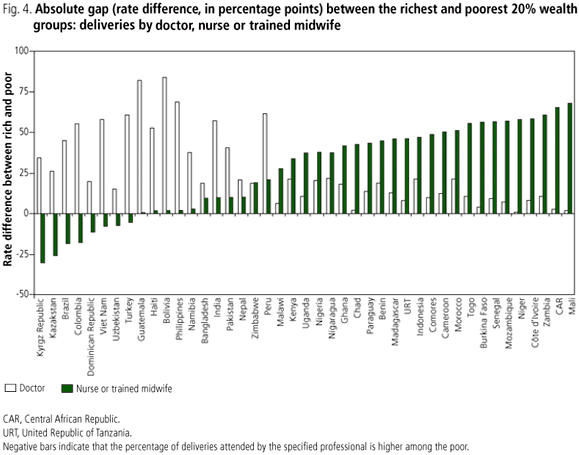
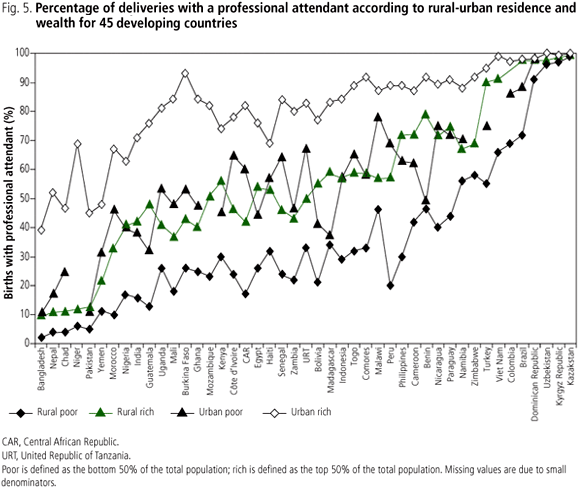
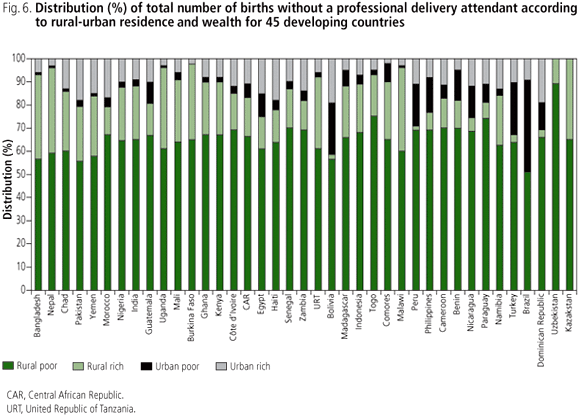
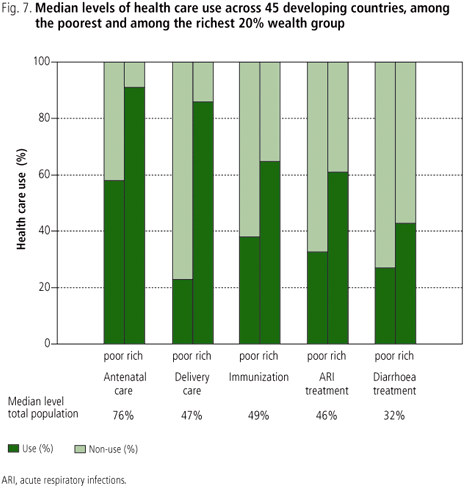

Results
Maternity care
Figs. 1 and 2 show the proportion of births for which professional antenatal care was received and the proportion of births attended by a professional for the five wealth groups, ranked by each countrys mean. Among the richest quintile, use of antenatal care and professional delivery care reaches levels of 80% or higher, irrespective of the average level in the country, with a few exceptions (Bangladesh, Chad, Nepal, Pakistan, Yemen). Use of these services is much lower among poorer women. Wealth and maternity care are linked across the entire wealth hierarchy within countries, with each progressively poorer group having progressively lower use. Importantly, poorrich inequalities in professional delivery care are much larger than those in antenatal care. Whereas professional delivery care among the poor is below 30% in many countries, antenatal care is at least 30% in most countries. To further our understanding of these huge inequalities in professional delivery care, we characterize various aspects of these inequalities below.
The absolute poorrich gap in deliveries in public and in private facilities respectively is described in Fig. 3. Use of both public and private facilities is lowest among the poorest. The Dominican Republic and Brazil are exceptions, with higher use of public facilities among the poor. The absolute poorrich gap is largest in the public sector, in part because private facility use is low in all groups. Relative poorrich inequalities are, however, larger in the private sector (results not shown), as also reported by others.9 Professional delivery care is nearly synonymous with facility-based care in most countries, with a few exceptions such as Haiti, Indonesia and Madagascar, where home delivery with a professional is relatively common (results not shown).
Fig. 4 shows the absolute poorrich gap in delivery care by a doctor and by a nurse/midwife respectively. In many countries, hardly any women are attended by a doctor and inequalities in professional delivery care therefore mainly consist of those in attendance by a nurse/midwife (e.g. Burkina Faso, Central African Republic, Chad, Mali, Niger). In countries where overall levels of professional delivery attendance are high, attendance by a nurse/midwife is higher among the poor (Brazil, Colombia, Dominican Republic, Kazakhstan, Kyrgyz Republic) while attendance by a doctor is much higher among the rich.
Levels of professional delivery attendance among the rural poor, rural rich, urban poor and urban rich are shown in Fig. 5. Professional delivery attendance is much higher in urban compared to rural areas. Within urban and rural areas, the poorrich gap in professional delivery attendance is large, despite comparing very broad wealth groups (poorest and least poor 50%). The rural rich and the urban poor have relatively similar levels of professionally attended deliveries in most countries.
Fig. 6 describes the distribution of the total number of deliveries without a professional attendant by rural/urban wealth groups. This takes into account both the rate of under-coverage in the groups and the relative size of these groups within the total survey population. Most of the births without professional delivery care occur among the rural poor (65% on average), followed by the rural rich.
Child health care
The median levels of use of maternal and child health care among the poorest and richest quintile across the 45 countries are shown in Fig. 7. Among the poorest, antenatal care is high and professional delivery attendance low compared to childhood immunization and treatment for acute respiratory infections (ARI) or diarrhoea. Despite similar overall levels of professional delivery care and immunization coverage (47% and 49% respectively), poorrich inequalities in professional delivery attendance are much larger. Non-use of antenatal and delivery care (indicated by the light green bars) is almost completely concentrated among the poor, underlining the extent to which maternity care is unequally distributed. In contrast, non-use of immunization and treatment of childhood illnesses is also high among the rich.
Fig. 8 shows the relationship between the size of relative inequalities in health care use and the overall levels of health care use for five types of health care. The fit of the curves was good (R² varying between 0.62 and 0.79) except for diarrhoea (R² = 0.29). Relative inequalities tend to be larger in countries with lower overall levels of health care use. At all overall levels, inequalities in professional delivery attendance and antenatal care are systematically larger than inequalities in the other types of care. Absolute poorrich inequalities also are systematically larger for professional delivery attendance and antenatal care (results available upon request).
Discussion
This paper shows that inequalities in the use of professional delivery attendance are extremely large, and much greater than inequalities in immunization coverage and medical treatment for childhood illnesses, even when overall levels of health care use are taken into account. Very few of the poorest mothers get professional delivery care irrespective of where they live, although some get antenatal care.
The burden of under-coverage of professional delivery care is concentrated in rural areas, particularly among the rural poor. Whereas poorrich inequalities within urban areas are large, the relatively small size of the urban population in general and the urban poor in particular explains the relatively small public health impact of these urban inequalities. As countries become progressively more urban, however, these inequalities will become progressively more important.
Public sector facilities rarely address the poorrich inequalities in professional delivery care. In absolute terms, poorrich inequalities in the use of public facilities usually are larger than private sector inequalities, suggesting that the public sector does not provide a safety net for the poor.
Our findings might stem from data artefacts. Differential reliability of morbidity data (with the poor underreporting mild forms of diarrhoea and ARI) might underestimate the poorrich gap in medical treatment, but there is no reason to assume that poor women systematically under-report professional delivery attendance or over-report immunization coverage (explaining larger poorrich inequalities in delivery care than in immunization coverage).17,18 Second, the wealth measure might partly capture rural/urban residence, as it includes assets that urbanites are more likely to own. Still, substantial poorrich inequalities in health care use within urban and within rural areas can be demonstrated.
If the larger inequalities in maternity care are not artefacts, they might be explained by demand factors, supply factors, or the nature of the service needed and provided.
Demand factors
Pregnancy and childbirth are imbued with strong cultural meaning,1921 and hence cultural factors may be more important determinants of uptake of maternity care than of other forms of care. Poorer women may prefer traditional birth attendants or family members,22 particularly if childbirth is seen as a non-illness event where modern medicine has little to contribute.23,24 Professional providers of maternity care may not be tolerant of cultural beliefs and practices.21 Sometimes, professional providers treat poor women with less consideration than richer or more educated women.25 Also, women may experience constraints on seeking care for themselves if relatives, particularly husbands or mothers-in-law, are heavily involved in the decision-making process;22,23,25 members of these poorer households may favour home-based delivery care. In some societies, this is related to norms of female seclusion. There is also evidence that families may be less willing to spend money on womens health, especially in south Asia.26 Male doctors may be a barrier for seeking facility-based delivery care;27 such cultural barriers may be fewer regarding childrens health care.28 In contrast, richer, often better-educated, women and their families may have a more modern world view, greater identification with the modern health care system, greater confidence in dealing with officials, and greater ability and willingness to travel outside the community,25 all of which may facilitate use of professional maternity care.
The argument that poor women or their families have a lower demand for professional delivery attendants assumes that they actually have a choice. In some settings, rural uneducated women deliver at home without professional care despite living in close proximity to maternity care facilities.29 Yet evidence from other countries suggests that poorer women tend to stop using traditional maternity care in contexts where medically trained, accessible, affordable and good-quality professional care becomes available,30 though they may be slower to adopt such care than rich women.31 This suggests that supply factors play an important role in explaining the huge poorrich inequalities in maternity care.
Supply factors
Availability and accessibility
Lack of availability and accessibility may be greater for professional delivery care than for other forms of care. Whereas the logistical requirements to provide full childhood immunization coverage are high (e.g. cold chain), many countries have adopted mobile immunization strategies that are therefore better able to achieve wide geographical coverage than strategies requiring fixed sites. Although some maternity care programmes have attempted to reach out to womens homes, most professional delivery care takes place in facilities. The physical infrastructure requirements are higher for facility-based delivery than for the provision of vaccinations or the treatment of ARI or diarrhoea. Moreover, providers of treatment for ARI and diarrhoea can include lower-level cadres, such as community health workers, who are more easily placed in remote or rural areas than doctors or nurses/midwives. Finally, more immunizations or treatments of ARI/diarrhoea can be done per provider per day than deliveries. Human resources and infrastructure for delivery care are seriously insufficient, with three times the current number of professionals needed to achieve universal professional delivery attendance.1,7 Indeed, the human resources crisis in the health care sector is particularly affecting professional delivery care services.1 The scarce delivery care facilities that are available tend to be concentrated in urban areas,32 whereas the bulk of the poor live in rural areas. A preliminary analysis in Mwanza, United Republic of Tanzania, suggests that the mean distance to delivery services is 28 km, compared to 78 km for treatment for sexually transmitted diseases, family planning and antenatal care.33 However, even within rural and within urban areas poorrich inequalities in professional delivery attendance are large.
Affordability
Lack of affordability might explain the large poorrich inequalities in professional delivery attendance within urban and within rural areas. We are unaware of studies in which costs to households of maternity care and other forms of health care are systematically compared. Yet vaccinations and basic treatment for ARI and diarrhoea at the primary-care level tend to be inexpensive or free. In contrast, the cost of delivery care can be an important barrier.34,35 Even where this service is officially free, hidden costs may add up to a substantial part of monthly income, or even several times monthly income.36 Normal deliveries can cost households 326% of their annual per-capita income.35 Moreover, costs of facility-based delivery can be unpredictable34 and costs of severe complications can have a catastrophic impact on household budgets (up to 90138% of annual per capita income);35 this may restrict demand.37 In countries in economic and political turmoil like Mongolia and Tajikistan, where levels of poverty have risen and health care systems have deteriorated, the use of professional delivery assistance has declined, and poorrich inequalities in such care have increased.38,39 There are some indications that costs are less a barrier to seeking antenatal care compared to delivery care.40
Nature of services needed and provided
The mode of delivery and timing of the various health care services might influence the magnitude of poorrich inequalities in the use of these services, both directly and via their availability and accessibility.
Professional delivery attendance is highly dependent on individual-level care-seeking, whereas immunization is, at least in some settings, based on mass campaigns. There are indications that mass immunization campaigns can improve coverage, reach a high proportion of children that are difficult to reach through routine activities, and can reduce poorrich disparities in a short period of time.41 Outreach activities have been suggested to reduce socioeconomic inequalities in immunization coverage.42
Poorrich inequalities might also be larger when services require action at a very specific point in time. Deliveries and treatment for ARI/diarrhoea are have a short time-window in which care can be sought. This contrasts to antenatal care43 and immunization, for which there is more time to seek care. Moreover, the onset and timing of labour is less predictable.
Conclusion
We found substantial inequalities in professional delivery care that were greater than for other forms of care. A combination of the supply and demand factors and the nature of the service probably explains the much larger inequalities seen; the mixture of factors is likely to vary among countries. In some, accessibility/availability might be important. In the Central African Republic, Malawi and Senegal, for example, professional delivery attendance among the urban poor was much higher than among the rural rich, suggesting that availability/accessibility in rural areas is a problem. In contrast, in Benin, Madagascar and Pakistan professional delivery attendance among the urban poor was as low as among the rural poor, suggesting that other factors, such as costs, play a more important role. In other countries, cultural constraints might be of greater consequence.
We noted with interest that the rural rich and the urban poor had similar levels of delivery attendance in many countries. It may be that money can overcome access difficulties in rural areas, or that the rural rich are innovators. Further in-depth analysis of these population groups could help us understand the determinants of poorrich inequalities in maternity care use.
The huge inequalities in maternity care underline the need for effective provision of services. Over the last decades, countries have introduced various strategies to increase demand for22,44,45 and improve availability,30 accessibility23 and affordability46,47 of professional delivery attendants. Some, such as Indonesia, have focused on improving the availability of a narrow range of maternity care services (home-based midwifery in particular), whereas others, such as Cuba, Honduras, Sri Lanka and Kerala, have sought to improve the availability of a broader range of health services, including maternity care.30,48
Interventions have focused mostly on improving average levels of professional delivery care, and their differential effects often have not been adequately studied. Our paper provides detailed evidence on poorrich inequalities in professional delivery care, and discusses these huge inequalities in terms of comparisons with other types of health care. Reducing the poorrich inequalities in professional delivery care is essential for achieving the MDGs for maternal health. More evidence is needed on what works to reach lower socioeconomic groups, and on how effective interventions can be scaled up to entire national populations.22 Different contexts may require different interventions to reduce inequalities, and factors influencing the transferability of interventions between contexts should be mapped. A concerted effort of equity-oriented research, policy-making and monitoring is needed to reduce the huge poorrich inequalities in delivery care described in this paper. 
Competing interests: None declared.
References
1. The World Health Report 2005: Make every mother and child count. Geneva: World Health Organization; 2005.
2. United Nations Millennium Declaration, Resolution A/RES/55/2. New York: United Nations; 2000.
3. Campbell O. Measuring progress in Safe Motherhood: uses and limitations of health outcome indicators. In: Berer M, Ravindran TS, eds. Safe Motherhood Initiatives: Critical Issues. London: Blackwell Science Limited; 1999.
4. de Bernis L, Sherratt DR, AbouZahr, C, Van Lerberghe, W. Skilled attendants for pregnancy, childbirth and postnatal care. Br Med Bull 2003;67:39-57.
5. Millenium Development Goals. Available at: www.developmentgoals.org Washington: World Bank; 2007.
6. Lawn JE, Tinker A, Munjanja SP, and Cousens S Where is maternal and child health now? Lancet 368 (9546): 1474-7 (2006).
7. Koblinsky M, Matthews Z, Hussein J, Mavalankar D, Mridha MK, Anwar I, et al. Going to scale with professional skilled care. Lancet 2006;368:1377-86.
8. Gwatkin DR, Rutstein S, Johnson K, Pande RP, Wagstaff A. Socio-economic differences in health, nutrition, and population. Washington: World Bank; 2000.
9. Gwatkin DR, Bhuiya, A. & Victora, C.G Making health systems more equitable. Lancet 2004;364:1273-80.
10. Graham WJ, Fitzmaurice AE, Bell JS, Cairns JA The familial technique for linking maternal death with poverty. Lancet 2004;363:23-7.
11. Ronsmans C, Graham WJ. Maternal mortality: who, when, where, and why. Lancet 2006;368:1189-200.
12. Gwatkin DR, Rutstein S, Johnson K, Pande RP, Wagstaff A. Socio-economic differences in health, nutrition, and population. Available at: http://go.worldbank.org/0R6HU8YXE0 Washington: World Bank. 2007
13. Demographic and Health Surveys. Available at: www.measuredhs.com Calverton: Measure DHS; 2007
14. Filmer D, Pritchett LH. Estimating wealth effects without expenditure data or tears: an application to educational enrollments in states of India. Demography 2001;38:115-32.
15. Houweling TA, Kunst AE, Mackenbach JP. Measuring health inequality among children in developing countries: does the choice of the indicator of economic status matter? Int J Equity Health 2003;2:8.
16. Bollen KA, Glanville JL, Stecklov G. Economic status proxies in studies of fertility in developing countries: does the measure matter? Population Studies - A Journal of Demography. 56 (1): 81-96 (2002).
17. An assessment of the quality of health data in DHS-I surveys. Calverton: Macro International; 1993.
18. Boerma JT, Black RE, Sommerfelt AE, Rutstein SO, Bicego GT Accuracy and completeness of mothers recall of diarrhoea occurrence in pre-school children in Demographic and Health Surveys. Int J Epidemiol 1991; 20:1073-80.
19. Blanchet T. Meanings and rituals of birth in rural Bangladesh. Dhaka: University Press Ltd; 1984.
20. MacCormack CP. Ethnography of fertility and birth, 2nd ed. Prospect Heights: Waveland Press; 1994.
21. Jaffre Y, Prual A. Midwives in Niger: an uncomfortable position between social behaviours and health care constraints. Soc Sci Med 1994;38:1069-73.
22. Ensor T, Cooper S. Overcoming barriers to health service access: influencing the demand side. Health Policy Plan 2004;19:69-79.
23. Thaddeus S, Maine D. Too far to walk: maternal mortality in context. Soc Sci Med 1994;38:1091-110.
24. Neema S. Mothers and midwives: maternity care options in Ankole, South Western Uganda. Copenhagen: University of Copenhagen; 1994.
25. Cleland JG, v Ginneken JK. Maternal education and child survival in developing countries: the search for pathways of influence. Soc Sci Med 1988;27:1357-68.
26. Kutzin J. Obstacles to womens access: issues and options for more effective interventions to improve womens health. Washington: World Bank; 1993.
27. Delaney C. The seed and the soil:gender and cosmology in Turkish village society. Berkley: University of California Press; 1991.
28. Blum LS, Nahar N. Cultural and social context of dysentery: implications for the introduction of a new vaccine. J Health Popul Nutr 2004;22:159-69.
29. Rasheed P, Khan A. A multifactorial study of birth place options: improving health care delivery in Saudi Arabia. Int J Gynaecol Obstet 1990;33:229-34.
30. Koblinsky MA, Campbell O, Heichelheim J. Organizing delivery care: what works for safe motherhood? Bull World Health Organ 1999;77:399-406.
31. Victora CG, Vaughan, J.P., Barros, F.C., Silva, A.C. & Tomasi, E. Explaining trends in inequities: evidence from Brazilian child health studies. Lancet 2000;356:1093-8.
32. Wilkinson MI, Wamucii Njogu, Abderrahim N. The availability of family planning and maternal and child health services. Columbia: Macro International; 1993.
33. Slaymaker E. Universal access to reproductive health by 2015: how do we measure progress towards this target? IUSSP meeting on Taking Stock of Data Needs and Monitoring for the MDGs in Developing Countries. Rabat, Morocco, 2007.
34. Kowalewski M, Mujinja P, Jahn A Can mothers afford maternal health care costs? User costs of maternity services in rural Tanzania. Afr J Reprod Health 2002;6:65-73.
35. Borghi J, Ensor T, Somanathan A, Lissner C, Mills A Mobilising financial resources for maternal health. Lancet 2006;368:1457-65.
36. Nahar S, Costello A. The hidden cost of free maternity care in Dhaka, Bangladesh. Health Policy Plan 1998;13:417-22.
37. Borghi J, Hanson K, Acquah CA, Ekanmian G, Filippi V, Ronsmans C, et al. Costs of near-miss obstetric complications for women and their families in Benin and Ghana. Health Policy Plan 2003;18:383-90.
38. Falkingham J. Inequality and changes in womens use of maternal health-care services in Tajikistan. Stud Fam Plann 2003;34:32-43.
39. Janes CR, Chuluundorj O. Free markets and dead mothers: the social ecology of maternal mortality in post-socialist Mongolia. Med Anthropol Q 2004;18:230-57.
40. Prata N, Greig F, Walsh J, West A. Ability to pay for maternal health services: what will it take to meet WHO standards? Health Policy 2004;70:163-74.
41. Zuber PL, Conombo KS, Traore AD, Millogo JD, Ouattara A, Ouedraogo IB, et al. Mass measles vaccination in urban Burkina Faso, 1998. Bull World Health Organ 2001;79:296-300.
42. Bishai D, Suzuki E, McQuestion M, Chakraborty J, Koenig M. The role of public health programmes in reducing socioeconomic inequities in childhood immunization coverage. Health Policy Plan 2002;17:412-9.
43. Amooti-Kaguna B, Nuwaha F. Factors influencing choice of delivery sites in Rakai district of Uganda. Soc Sci Med 2000;50:203-13.
44. Manandhar DS, Osrin D, Shrestha BP, Mesko N, Morrison J, Tumbahangphe KM, et al. Effect of a participatory intervention with womens groups on birth outcomes in Nepal: cluster-randomised controlled trial. Lancet 2004; 364:970-9.
45. Lanata C. Improving quality of care. Child Health Dialogue 2000;18:6.
46. Fofana P, Samai O, Kebbie A, Sengeh P. Promoting the use of obstetric services through community loan funds, Bo, Sierra Leone. The Bo PMM Team. Int J Gynaecol Obstet 1997;59:S225-30.
47. Chiwuzie J, Okojie O, Okolocha C, Omorogbe S, Oronsaye A, Akpala W, et al. Emergency loan funds to improve access to obstetric care in Ekpoma, Nigeria. The Benin PMM Team. Int J Gynaecol Obstet 1997;59:S231-6.
48. Ronsmans C, Endang A, Gunawan S, Zazri A, McDermott J, Koblinsky M, et al. Evaluation of a comprehensive home-based midwifery programme in South Kalimantan, Indonesia. Trop Med Int Health 2001;6:799-810.
(Submitted: 13 November 2006 Final revised version submitted: 15 March 2007 Accepted: 16 April 2007)
1 Correspondence to Tanja AJ Houweling (e-mail: a.houweling@ucl.ac.uk)
